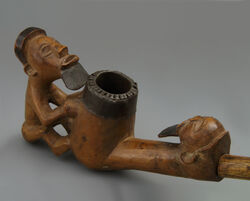Teke pipe with two figures
March 2024

In this tobacco pipe the basic shape of the European briar is visible, although the interpretation is completely African. We see a cylindrical pipe bowl with attached an ascending stem. Because of the soft wood from which the pipe is carved, the maker has lined the inside of the bowl with sheet metal to prevent burn-in. This has been done thoroughly, with first a band around the top of the pipe bowl and then the inside, the metal of which has been cut over the edge and folded over. The object is decorated with two carvings. The most dominant is a figure that sticks to the front of the bowl and clearly shows cubic features. Note the hands and feet, but also the square goatee. The second figure has the same character but only consists of a simple mask that marks the end of the tige. In both figures, parts have been coloured with black dye, such as the hair on the head and the goatee. A loosely trimmed wooden stem makes it possible to smoke the pipe. That part would have been made of vulcanized rubber in a European pipe, here a local type of wood has been used in a curve that is unusual for us. Later, the tribe often uses metal for the pipe stem. The cubic look of the figures and the stylistic features of the face indicate production by the Teke, a people living along the banks of the Congo River. The date of this pipe is in the first half of the twentieth century. The representation of the figure at the front of the pipe became so popular that it was regularly recut until the end of the twentieth century.
Amsterdam Pipe Museum APM 24.709
Archive object of month